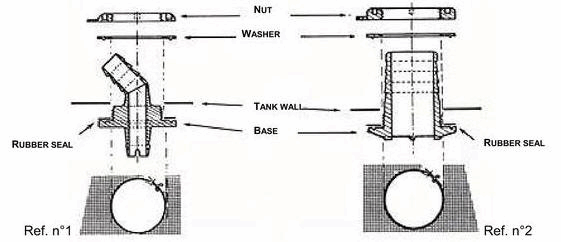CLOSE
WINDOW
INSTALLATION TIPS
It is advisable to install your NAUTA® flexible tank in a small “berth” which
will help to insure its protection against sharp objects. This berth prevents abnormal
wearing from abrasion.
Figure hose lengths with tank empty, and allow sufficient slack.
Use grommets for positioning only, not for supporting a loaded tank. When securing,
it is important to remember that tanks expand when loaded; a loose fit in the deflated
state or elastic tie-downs will work best.
FITTING THE CONNECTIONS
- Fitting of the connection is generally made on the same side of the
tank
- The position of the nipple will be so that there will be a minimum margin
of 100 mm between the connection and the edges of the tank
- Use the washer (see drawing) to mark out the circumference of the hole
to be made in the support. Its dimension must be the one of the washer inside.
- Then cut with scissors the marked out hole
NOTE: Take care to separate the two walls of the tank in order to
avoid to damage the opposite wall when cutting. It is also necessary to
take care not to make a hole of a bigger diameter then the one made in ref.
2
- Bring the edges of the hole nearer by pinching the fabric and introduce
the base of the nipple as a button in a button-hole
- Place the washer with the edge on fabric side (in order to ensure the
imperviousness) and then the screw ring
- Tighten the ring with the wrench
- Check the tightening periodically and in particular some days after
the fitting installation
|
 |
MAINTENANCENAUTA® flexible tanks
used for drinking water will operate more satisfactory if the following procedures
are observed. Before using for the first time, partly fill the tank with warm water
(50°c) and a 1% solution of mild detergent. After a few minutes, rinse with clear
water and fill it again with water treated with chlorine tablets (follow package
instructions for a 5% concentration). Empty after 2 hours and carefully and thoroughly
rinse with clear water. These cleaning procedures should be performed with the system
fully installed so that all the piping undergoes the same treatment.
When not using the tank for an extended period of time (winter layup…), keep
it partly filled with water and 10% of chlorine solution. Because it is not possible
to completely evacuate the tank, this procedure best prevents the development of
micro-organisms which could coat the inside and contribute to a bad taste in water.
Before using the tank again to service, follow the same procedure as used with a
new tank. Even if using your tank constantly, this cleaning procedure is recommended
every 6 months. Do not forget that the pipes also contribute to the water’s taste
and should be involved in the regular cleaning process.
CLOSE
WINDOW
